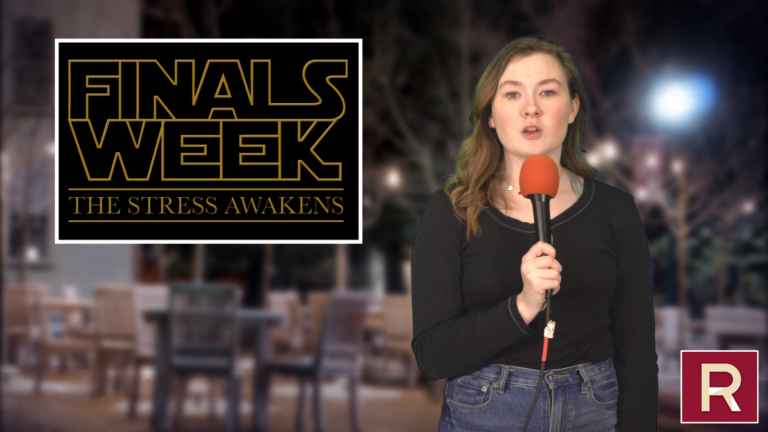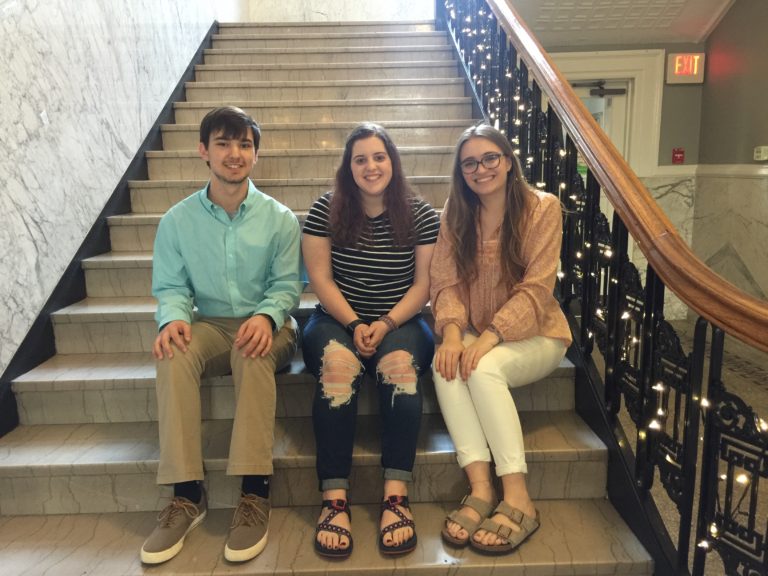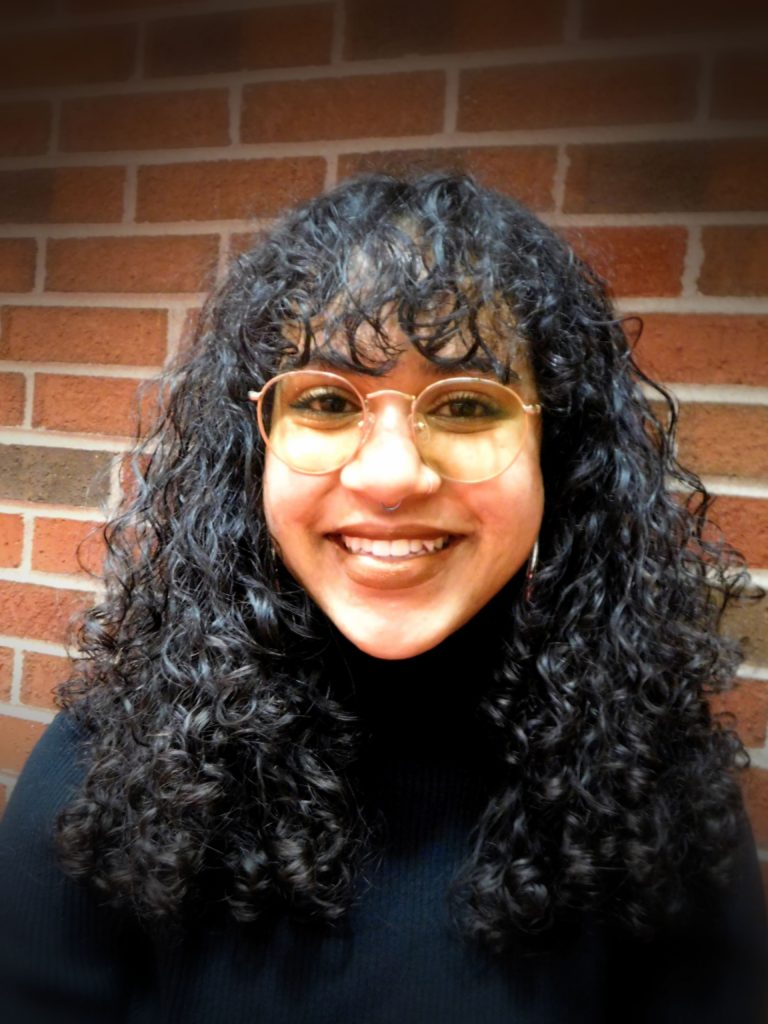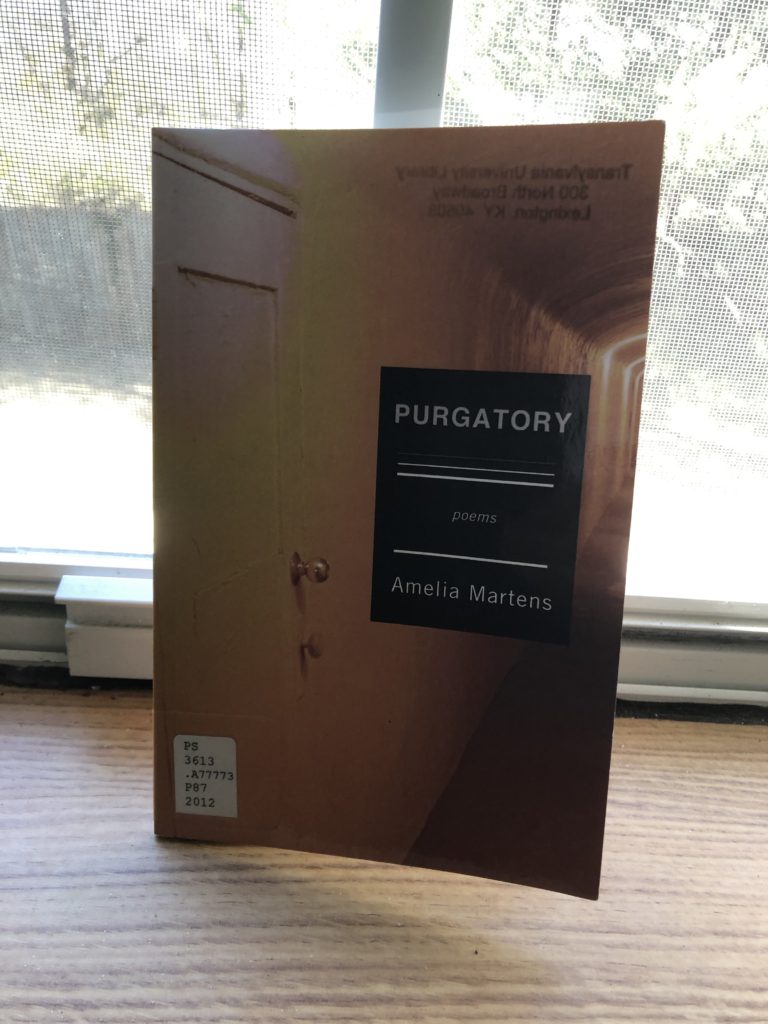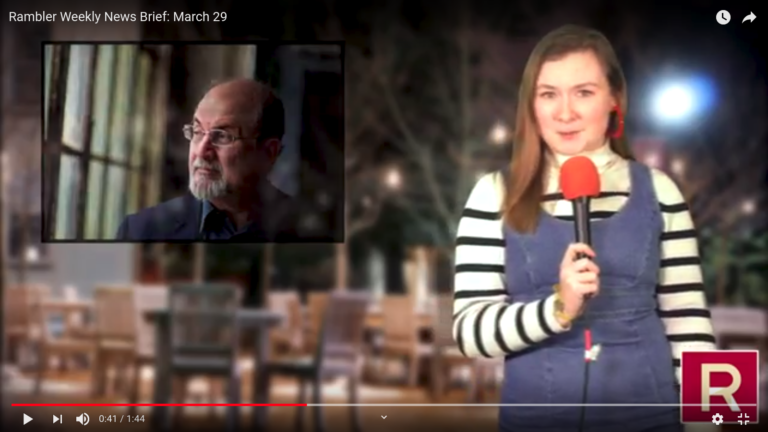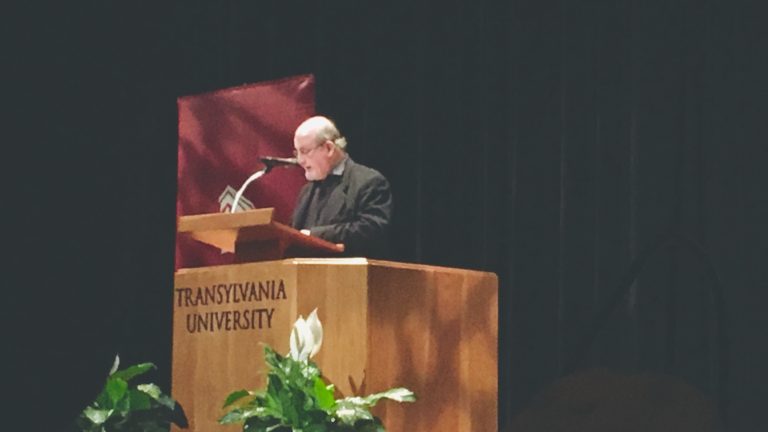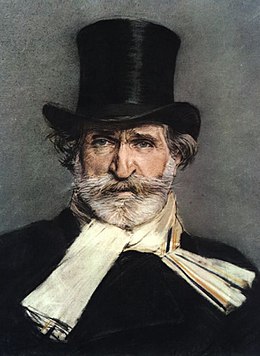Blog: Transy students attend volunteer appreciation dinner
Transy students Ryan Wood, Pamela Howarah, and myself were among some of the guests invited to attend the volunteer appreciation dinner on Wednesday evening at The Carnegie Center. Mayor of Lexington, Linda Gorton was also in attendance. Both Wood, who is a first year, and Howarah, who is a sophomore, along with myself are weekly tutors at The Carnegie Center, and specialize in either math, reading, or both.
The dinner is an annual event that honors the many volunteers serving The Carnegie Center. There was also a ceremony that honored attendees who had served in specific roles with The Carnegie Center, such as ESL (English as a Second Language) outreach programs that have impacted the community in a positive way.
The volunteers were served a dinner that was provided Pasta Garage Italian Cafe here in Lexington that included salad, bread sticks, pasta, and a delicious assortment of cheesecakes.
The Carnegie Center’s Children’s Outreach & Volunteer Coordinator, Erica Cook, announced that it wouldn’t be a Carnegie event if there weren’t hidden surprises. She told everyone to check underneath their chairs for a possible surprise, as not every chair had something taped underneath. I did so, and pulled out a gift card that can be used at Zim’s Cafe or Honeywood among other Lexington restaurants, while another person sitting at my table discovered a Third Street Stuff gift card hiding under their seat. The evening was a fun way to celebrate all of the hard work that is accomplished daily by the many volunteers at The Carnegie Center and their community programs.
Column: “On The Table” and Productive Communication
On The Table came into existence thanks to the effort the Chicago Community Foundation put forth to bring people to the table to talk about important and contentious issues. Sounds simple, right?
The Lexington Bluegrass Community Foundation’s third annual On The Table discussion happened simultaneously in the afternoon and evening of March 27, 2019. Discussions centered around the theme of Belonging. The goal of these discussions was to engage the public, bringing people to the table that may not feel welcome or included enough, to speak on issues that affect the community collectively.
This year, the conversations were meant to focus on race relations and social inequality, analyzed under the umbrella of belonging. Surveys, based on respondents’ perception from previous years have shown that these topics were not as heavily discussed and that they merit the attention they haven’t been given.
As a host, I was charged with inviting 8-12 guests to my table. I chose to include people in the Lexington community as well as those directly affiliated with the Transy community in an effort to facilitate conversation with people from two environments I identify with. My personal goal was to invite people who represented the spectrum of views on social topics, but I was unable to convince individuals who had preconceived notions of how people would respond to their moderate-to-conservative viewpoints. Those that accepted my invitation all had liberal-leaning views on social issues and those facing our community.
Throughout and after my table’s discussion, I thought about a question that was raised, and for a moment, caused silence: In this increasingly isolated world where people have the illusion of being ever connected through the internet, how do we make sure that people are engaging with others while respecting and celebrating our differences through shared experiences?
Presented with this question, I am confounded. Bringing people to the table is easy when they are already open to it, but what about the people who still feel apprehensive about the idea itself, let alone actually interacting with strangers whose opinions differ from what we have always known?
It is, in my opinion, the biggest issue that faces our society today: lack of productive communication. Civil (in person) discourse is incredibly important in connecting with people and understand others’ behavior, beliefs, and convictions. However, when people are simply hearing each other and not listening to each other, progress will never be achieved.
My social-justice-packed evening ended with Sir Salman Rushdie’s Creative Intelligence lecture “On Civility.” Among other things to think about, I walked away with this quotation: “…The great constant is human nature, what we have in common, left or right, black or white…” (Rushdie 2019).
Lit Review: Purgatory
Welcome to Lit Review, where columnist Dominiq Wilson will take apart a series of chapbooks to figure out what works and what doesn’t for the modern reader of poetry.
“Purgatory” is written by Amelia Martens, the same author of “The Spoons in the Grass Are There to Dig a Moat.” It’s a collection of 20 prose poems, and despite the various subjects this book discusses, all of them seem to take place in the middle of something like the title suggests.
Before going further, I will say that this chapbook wasn’t easy to navigate through. Each poem is untitled, which aids in the mystery of what point in time the poems take place, but when going back into the table of contents, the poems were marked by the first few words. Luckily for me, each poem is under a page long, so I will be referring to each poem by its page number.
It was clear to me that all of these poems are written in prose form, but unlike her other chapbook, these poems seemed to resemble streams of consciousness in the fact that some of these poems seemed to go off into an unplanned direction.
Having read Martens’ poetry before, I can say that this revelation isn’t new, but due to the wedge of time between the first reading and the second, I can say that I was thoroughly confused by these disconnected, run-on sentences. Despite this, as always, it made these poems very enjoyable to read. Take the third, for example:
“You stare at the electric coil, and wait for your watched pot to boil. You wear the first apron your mother made, out of the rocking horse curtains. Every time you take the lid off, the water is serene. Camel crickets skitter across the peach linoleum, and jump on a collision course with the backs of your bare knees. You wear white socks, the left one wet from the ice cube left to die just outside the freezer. You hold a baby spoon and tweezers. You realize, as you hear the roll of heat inside the thin tin pot, there is nothing to boil, nothing but insects.”
I noted that this poem may be about a lost family, considering the narrator mentions a mother-made apron and baby spoon without mentioning a mother or baby, but I can’t be too sure. There’s a lot of unnecessary information that throws that inference off.
Like her last book, Martens comments on social issues. In “The Spoons in the Grass Are There to Dig a Moat,” she commented on war and its effects on individuals and families, but she addresses other issues as well, such as beauty and the environment. The fifteenth poem mentions plastic almost too many times for me to think that the poem isn’t commenting on the use of plastic in our environment. Read it below:
“Your happiness is funded by solar panels and social security. Every day you sit on a park bench in the plastic universe and listen to the plastic blue bird feed his plastic chicks. Across the park, near the plastic public restroom, sits a mathematician. He eats egg salad sandwiches every day. First, he unwraps the plastic. You watch him do this through the figure eight of your plastic binoculars; the ones your parents would never let you use because they were afraid you’d break the glass lenses. Even now you feel their weight, and the plastic strap pulls on your neck when you let the lenses fall against your chest. All your life they never saw you, sitting in the backseat. Your face pressed against the window, tracking raindrops, the soft plastic of the window knob turning in your hand; there impressions were made, which looked like scars as you aged. You silly putty child, when are they coming to pick you up off this bench and put you back inside your egg?”
I enjoyed this book about as much as I loved her first, though the poems not having titles was a bit annoying while reading. Despite that, I do recommend that anyone should read it. You can buy it for around $9 or check it out in our campus library.
Further Reading: Department of Education Report Calls on Colleges to Step Up Support for Poor Students
This story originally appeared on ProPublica and is republished here under a Creative Commons License. The story was originally written by Annie Waldman. You can read the original story here.
Department of Education Report Calls on Colleges to Step Up Support for Poor Students
Colleges should be doing more to recruit low-income students and to support them as they work to finish their degrees, says a new report released last a week ago by the U.S. Department of Education.
The report also shines a light on the successes some colleges have had in promoting greater access to low-income students and increasing graduation rates.
“Many colleges and universities have taken important steps to make college a reality for low income students, but unfortunately today those success stories are the exception–they ought to be the rule,” said Education Secretary John B. King, in a press briefing yesterday. “There are far too many barriers preventing far too many low income students from enrolling in and graduating from college.”
Last year, a ProPublica analysis of federal data found that many wealthy colleges leave poor students with large debts. We also found that while some wealthy schools give big discounts to poor students, they also admit few of them. (In our interactive database, Debt by Degrees, you can look up how well a college is supporting its low-income students.)
Stephen Burd, a senior policy analyst from the New America foundation, believes that many colleges need to better prioritize low-income students in the admission process.
“Unfortunately, many schools are more focused on increasing their prestige and revenue than making college accessible and affordable for those who come from less privileged backgrounds,” said Burd. “It’s critical that we bring attention to those that are failing to enroll low-income students or support them adequately.”
The new report also calls on schools to improve the graduation gaps between poor and wealthy students. As we previously reported, low-income students struggle more to complete their degrees than their wealthier peers. On average, 51 percent of Pell recipients–students whose families typically make less than $30,000 year–graduate from college, compared to 65 percent of non-Pell recipients.
Debt by Degrees
Which colleges help poor students most? Explore the app.
Colleges Flush With Cash Saddle Poorest Students With Debt
A ProPublica analysis of newly available federal data shows that some of the nation’s wealthiest colleges are leaving their poorest students with plenty of debt. Read the story.
“For years, colleges and universities have adopted an approach that was around admitting the best students they could and the onus was on the student to make it,” said Andrew Nichols, a researcher at The Education Trust whose data underpinned the report. “Now we look at it differently. We understand that you can’t put all the responsibility on the student. Certainly they need to do their part, but there are things colleges and universities can do.”
The report comes on the heels of recent proposals from the White House to improve access and outcomes for low-income students. The administration has recently proposed expanding access to Pell Grants by allowing year-round eligibility to the program.
Additionally, President Obama made a splash during last year’s State of the Union address, when he proposed making two years of community college free to all students. Earlier this year, he also asked Congress to permanently index Pell Grants to inflation, an adjustment that is set to expire after 2017.
ProPublica is a Pulitzer Prize-winning investigative newsroom. Sign up for The Big Story newsletter to receive stories like this one in your inbox.
Rambler Weekly Blog & Playlist: March 29
Hey everyone!
It’s time for another music video playlist! This week, we have some new music from classics like Ice Cube and P!nk! Don’t forget to send your suggestions and requests to tmahlinger20@transy.edu!
Khalid released the music video for his hit single “Talk” ft. Disclosure a couple of weeks ago, which has gained over 15 million views. This is the lead single off Khalid’s new album Free Spirit which is expected to drop early next month. The video is mostly a vibrant array of colors, yet simple with the set design, which reminds me of Drake’s music video for “Hotline Bling.” This is definitely worth the watch if you want a fun, colorful video with lots of dancing and good vibes.
P!nk fans, get hype because she’s back with another hit single and music video that was directed by Michael Gracey, according to Billboard Magazine, who was also the director of The Greatest Showman. P!nk has confirmed that she will be releasing a new album titled Hurts 2B Human next month, which is big news, since the singer hasn’t released a new album since 2017’s Beautiful Trauma. Watch P!nk in this video as she walks around in a red dress surrounded nothing but an empty city and mysterious shadows.
Ice Cube is back with a new single called “Ain’t Got No Haters” ft. Too $hort and released the video for it just a few days ago. The video is set in black and white and consists of Ice Cube and Too $hort dancing around with cartoon illustrations floating around every now and then and dollar bills showering them. The song itself has that classic Ice Cube feel that his fans know and love. Watch this video for a simple, classy vibe.
Stay chill,
Taylor
As for arts events, we have a few this week!
Tuesday, April 2nd @7:30pm, MFA Carrick Theater
The first General Student Recital kicks off finals season for the music students! Come support them in the first round!
Wednesday, April 3rd @7:30pm, MFA Haggin Auditorium
Join Transylvania’s Chamber Orchestra for a night full of great music!
Thursday, April 4th @12:30pm, MFA Carrick Theater
Come support Transy’s music students in the second round of General Student Recitals!
Transy changes food services provider to Bon Appétit
The change in food services on campus is a topic that students have been abuzz about since the switch was announced. The email describing this change came basically out of the blue; however, the switch might have been expected in light of the complaints held by students on the caf’s recent decline.
“There have been limited options and the entree section has been pretty gross and flavorless. There’s nothing that’s reliably good,” says first-year Molly Uhls.
The switch in food services is something current students are looking forward to and could potentially be another way Transy could gain prospective students. This change has also brought lots of questions. Luckily, Vice President of Business and Finance, Marc Mathews, was able to explain the change a bit deeper than the campus-wide email did.
Mathews explained how the original notion to change food services came after Sodexo’s failure to meet the nutritional and standardized goals Transy wants to set. According to Mathews, this change has been in the works since this past summer.
One of the major complaints surrounding the current food situation on campus is an overall lack of variety. Unlike Sodexo, Bon Appétit does not operate on a national menu with a set rotation. Mathews explains, “the executive chef on site makes the menu each week so there is a greater option for variety. Also, the decision maker is right here on campus, so we can talk to the chef and enact immediate changes.”
Along with the changes to the main cafeteria, there will also be a few other differences in dining on campus.
One of these revisions will be to the campus staple, Jazzman’s. Since Jazzman’s is a Sodexo brand, this will be the coffee shop’s last year on campus. However, Bon Appétit will be bringing in a new coffee shop in the same location. Mathews explains, “Bon Appétit plans to serve locally roasted coffee and local pastries, such as North Lime Donuts and Great Bagel bagels.”
Another change in dining on campus will be an additional café added in the new campus center building, facing back circle, taking the place of The Rafskeller.
One thing that is not changing immediately is the meal plan set up and prices. Mathews explains that the current system and prices will stay in place at least for the upcoming year.
Sir Salman Rushdie delivers lecture “On Civility”
Sir Salman Rushdie came to campus this past Wednesday evening to deliver a lecture, “On Civility.” The lecture, and the Q&A section immediately following, were well-attended by both the Transy and Lexington communities—tickets for the event, although offered for free, were sold out well in advance of the doors to Haggin Auditorium opening.
Rushdie, in his remarks, used the theme of civility as a gateway into a discussion of American and world history, as well as the current political climate in the United States and across the world. He began his remarks by stressing that civility must be understood as “something wider and deeper than mere politeness,” and that a civil society must before all else be a “society of equals.”
This society is something that we have not achieved, he argued, noting the colonial abuses which have concentrated wealth in a handful of countries. He said that “when the British came to India, it was one of the richest countries on Earth. When they left, it was one of the poorest.” He also identified the continuing dangers of white supremacy and anti-migrant xenophobia as threats to a society of equals.
Rushdie identified a societal breakdown in civility as a downstream effect of a breakdown in public faith in governmental and societal institutions, and a breakdown in public understanding and acceptance of an idea of objective truth.
He warned that a rising tide of incivility was tied to a “rising tide of fascism” around the globe; he identified, among others, Rodrigo Duterte in the Philippines, Narendra Modi in India, and Viktor Orbán in Hungary as leaders of this rising tide. He also warned that the rise of the internet and global cultural ties has led to a situation in which “a white supremacist flaps his wings in America, and another such one murders in New Zealand.”
While Rushdie noted that incivility has a “long history” that predates the current political crises, he also warned that the current political climate, in the United States and abroad, was not within what he considered the normal historical bounds of “political insults.”
Rushdie simultaneously insisted that, as a political principle, the First Amendment and the broader principle of free speech be defended, saying that when “we can relentlessly disagree—in peace—that’s freedom.” This often requires the defense of what Rushdie called “uncivil behavior.” To illustrate his point, he said that “if flag burning is a freedom, then so is carrying a Nazi flag.”
Towards the end of the lecture, he had found a middle ground, in which uncivil behavior might be constitutionally protected, but sanctioned quite harshly by civil society. He concluded by admitting that, “I don’t want to talk to bigots. I want to beat them at the ballot box, and marginalize them in every discussion.” He deemed some forms of incivility more acceptable than other forms, such as when those without social power challenge those with it, as opposed to when those with power use the norms of civility to continue to repress those already repressed.
He concluded with remarks on the power of literature to “find our way back to each other, and reestablish the common ground of our society.”
Rushdie is one of world literature’s most prominent authors. In 1981, he won the Man Booker Prize, which is one of the highest honors in English-language literature, for his second novel, Midnight’s Children. He has since published sixteen further novels, several collections of essays, short stories, children’s stories, and other works. He was created a Knight Bachelor by Queen Elizabeth II for his services to literature.
In 1988, his life became the center of a major international controversy with the publication of his novel The Satanic Verses. While the novel is a wide-ranging work that deals with issues of identity and migration, two of the middle chapters deal with a crisis of faith experienced by one of the main characters by relating several dream sequences. These sequences draw inspiration from early Islamic history and early Islamic theological disputes, and some Muslims took offense to what they read as blasphemous depictions of the Prophet Muhammed.
The controversy was globally inflamed by political actors. In Iran, the fundamentalist Islamic cleric and head of state the Ayatollah Khomenei issued a fatwā1 A fatwā is a jurisprudential ruling in Islamic legal tradition. While today many Westerners associate the fatwā with radicals and fundamentalists, it is a widely-used term in Islamic theologies of all stripes. calling for his followers to assassinate the author. The fatwā resulted in Rushdie receiving police protection from the British government (he resided in Britain at the time), and in his assuming a fake identity for several years. He has since written a memoir of that time, titled Joseph Anton, after the alias he used.
Rushdie has written in the past that the controversy began and was sustained for political reasons, saying specifically that Khomeini used the fatwā as a tactic to unify the disparate elements of Iranian government and society at the time, and that both British and Indian politicians used the controversy to court Muslim votes in their respective elections.
The lecture by Rushdie was part of both the Kenan Lecture series and the Creative Intelligence Lecture Series, both sponsored by Transylvania University. Sir Salman Rushdie was the 52nd Kenan Lecturer. Rushdie also met with a group of Transylvania students earlier in the day to discuss literature and his creative process.
Transy Choir joins forces with Lexington Philharmonic to present the Verdi Requiem
The Lexington Philharmonic gave their second concert of the 2018-2019 season last Friday evening at the Singletary Center for the Arts. While there was only one piece on the program, the monumental “Requiem” by Giuseppe Verdi, the concert required a larger-than-usual Philharmonic Orchestra, a full set of four soloists, and over 150 singers drawn from Berea College, Asbury University, Transylvania University, and Eastern Kentucky University.
Conductor Scott Terrell, in his final season at the Philharmonic, led the orchestra and singers for a passionate and fiery (even occasionally apocalyptic) performance. To understand the depth of the performance required, it might be helpful to discuss the history of the “Requiem” (Mass for the Dead).
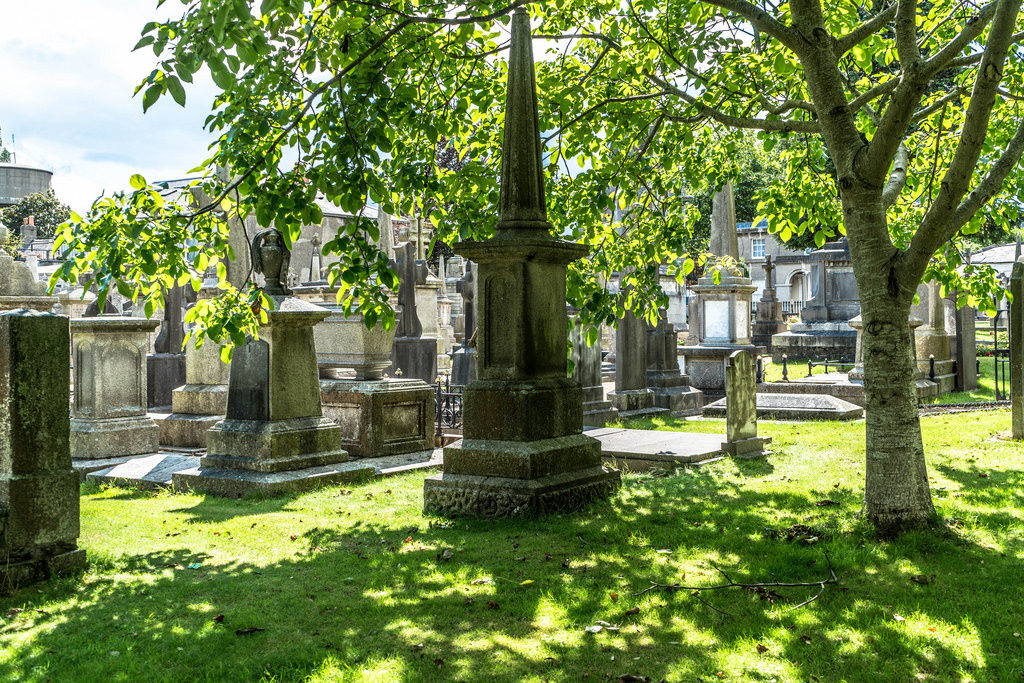
Verdi wrote the “Requiem” between 1868 and 1874, and it was composed to commemorate the death of the Italian poet & author Alessandro Manzoni, who was a friend of Verdi’s. (Verdi had written the final movement, titled “Libera Me” (Deliver Me), for a concert commemorating the death of fellow composer Giacchino Rossini, but had shelved it for several years). For a time after it was called the “Manzoni Requiem,” but as the reputation of the piece grew it lost its specific connotations.
The piece today is one of the most-widely-performed choral works, despite the fact that it calls for a rather large orchestra & choir, as well as the efforts of four soloists.
On a historical note, the inclusion of the female voices, and particularly the female soloists, was a point of minor controversy at the time of the Requiem’s premiere; women were not allowed to participate in the performance of the funerary rites of the Catholic Church at the time.
But what a loss it would have been on Friday evening had the soprano and mezzo-soprano parts never been written! D’ana Lombard as the soprano and Nancy Maultsby as the mezzo soloists were practical forces of nature, firing their voices across the length of the hall over the roars of an orchestra that included eight entire trumpets. Maultsby, in particular, gave a sublime performance, by turns measured in a mournful lyricism and soaring on the passionate declamatory sections.
Stylistically, the piece is noted for its operatic, theatrical tone—fitting, as Verdi was primarily an opera composer (as he is still known as such today). The height of this style comes early in the piece, with the “Dies Irae” (usually translated as The Day of Wrath or The Day of Judgment); this movement is most likely the most familiar piece of the Requiem for most listeners—it’s been used in everything from “The Simpsons” to “Mad Max: Fury Road” and “Django Unchained.”
The combined collegiate choirs boomed, rang, and descanted their way through the almost-demonic “Dies Irae,” the full performance of which took about half an hour. While the choir has the showy (and memorable) opening theme, bass soloist Peixin Chen dazzled with the full range of the low voice through the “Mors Stupebit” (Death is Struck) section. The orchestra also got its share of major moments, from a set of trumpets that traded horn calls across the breadth of the hall like hunters finding each other in the woods, to a set of bass drums that gave reports of thunder like the clouds discharging armies of avenging angels.
At the moments of highest intensity, each part of the vast ensemble seemed to momentarily overtake all the others, until another voice crashed over the hall like a wave, followed by another, and a further peak after that, practically until time seemed suspended—in such a way was eternity composed.
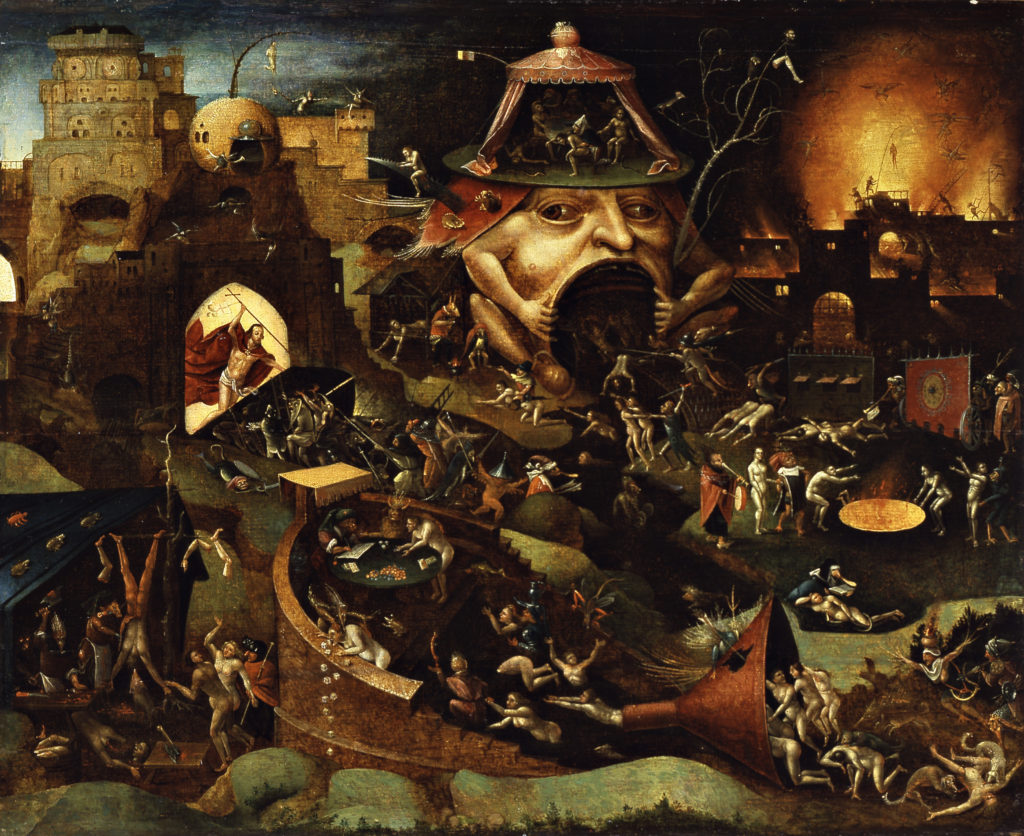
After the “Dies Irae”, the “Requiem” finds moments of quietude and stillness in the Offertory movement, although with a boisterous ending of the choir.
The “Sanctus” movement is strutted in one of the most difficult forms in all of music: a double fugue. Now, a fugue is a musical structure where one voice starts a melody, a second voice answers, a third voice replies to the second, a fourth to the third, and so on and so on and so on; now double that and you have a double fugue. Most composers only attempt a fugue at the absolute height of their abilities, and a double fugue is showing off to a degree that’s practically unbearable. Nevertheless, Terrell and choirs were able to keep the structure of the piece clean and clear, even at the points of maximum overlap and possible confusion—this is no modest feat.
Throughout the piece, each component of the ensemble—orchestra, soloists, and choirs—strove to keep the whole effect clear, even while the maximalistic dynamic range of Verdi’s score made it nigh-on impossible to balance a single solo voice against an entire set of strings. By the end of the evening, the final two movements, “Lux Aeterna” (Eternal Light) and “Libera Me,” each gesture, no matter where it was situated in the sections, seemed to melt into the next, as if a great effort had been expended to launch the hall towards the heavens, and the music could now float, weightlessly, in orbit.
The concert proper ended on a quiet sigh, a C major chord, one of the most simple and pure sounds available to a classical composer. But the roaring applause of the hall ended the night on a note that celebrated life after mourning death.


